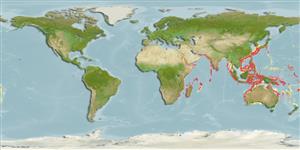Common names from other countries
>
Acropomatiformes (Oceanic basses) >
Acropomatidae (Lanternbellies, temperate ocean-basses)
Etymology: Acropoma: Greek, akro = topmost, summit + Greek, poma, -atos = cover (Ref. 45335).
More on author: Günther.
Environment: milieu / climate zone / depth range / distribution range
Ecología
marino batipelágico; rango de profundidad 35 - 100 m (Ref. 123727). Deep-water; 36°N - 37°S, 21°E - 154°W
Western Pacific: Japan, East China Sea and South China Sea.
Tamaño / Peso / Age
Maturity: Lm ? range ? - ? cm
Max length : 8.1 cm SL macho / no sexado; (Ref. 123726)
Short description
Claves de identificación | Morfología | Morfometría
Espinas dorsales (total) : 9; Radios blandos dorsales (total) : 10; Espinas anales: 3; Radios blandos anales: 7. Body moderately elongate, compressed. Scales large, weakly ciliated and deciduous. Two luminous organs run longitudinally in the abdominal muscle from the thorax to slightly beyond the anus and join each other at the anterior extremities.
Inhabits sand and sandy mud bottoms (Ref. 11230). Marketed fresh or reduced to fishmeal.
Life cycle and mating behavior
Maturities | Reproducción | Spawnings | Egg(s) | Fecundities | Larva
Okamoto, M., J.E. Randall, H. Motomura, 2021. Acropoma musortom, a new lanternbelly (Acropomatidae) from the South Pacific and the first record of Acropoma splendens from the Andaman Sea off southwestern Thailand. Ichthyol. Res. 68(4):517-528. (Ref. 123726)
IUCN Red List Status (Ref. 130435)
CITES (Ref. 128078)
Not Evaluated
Threat to humans
Harmless
Human uses
Pesquerías: comercial
Herramientas
Special reports
Download XML
Fuentes de Internet
Estimates based on models
Preferred temperature (Ref.
115969): 11.8 - 21.3, mean 15.7 (based on 290 cells).
Phylogenetic diversity index (Ref.
82804): PD
50 = 0.5156 [Uniqueness, from 0.5 = low to 2.0 = high].
Bayesian length-weight: a=0.01148 (0.00696 - 0.01895), b=2.99 (2.85 - 3.13), in cm Total Length, based on LWR estimates for this species & (Sub)family-body (Ref.
93245).
Nivel trófico (Ref.
69278): 3.3 ±0.40 se; based on food items.
Resiliencia (Ref.
120179): Medio, población duplicada en un tiempo mínimo de 1.4-4.4 años (Assuming tmax>3).
Fishing Vulnerability (Ref.
59153): Low vulnerability (10 of 100).
